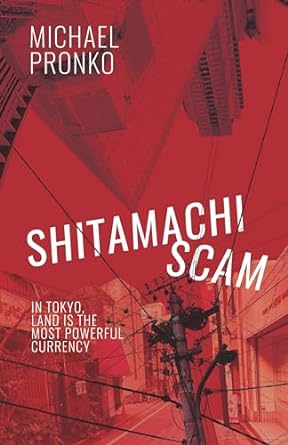The Bottom Line: A stunning crime thriller in which the brilliant, fussy Detective Hiroshi deftly unravels a truly masterful criminal enterprise.

Michael Pronko’s newest Detective Hiroshi novel finds the brilliant police investigator — who is typically more comfortable behind a desk – taking to the streets in a deadly undercover sting operation.
Hiroshi watches as the intended target, an elderly woman named Ueno, is accosted outside a bank by a scam artist named Takuya. Ueno does exactly what the police trained her to do, but their plan ends in disaster when a teenaged bag snatcher on a scooter comes out of nowhere. The ensuing accident kills Ueno and badly injures the driver, while Takuya escapes in the rambling lanes of old Tokyo.
What are the odds that two thieves would target the same victim at the same time? Takuya – the leader of a group that routinely scams elderly women – thinks he may have been set up. Hiroshi doesn’t believe in coincidences, either – a hunch that is confirmed when he interviews the scooter driver’s accomplice. The forensic accountant will soon learn that the scam they’ve been investigating is only a small piece of a far larger and more sinister operation targeting the elderly.
With each Hiroshi series novel, Pronko reveals increasingly visceral details about the detective’s weaknesses and peculiar superpowers – a series-long character arc that is endlessly entertaining. Here, the always-squeamish Hiroshi actively avoids looking at the crime scene photos, and can barely stand to hear about second-and-third-degree skin abrasions. Conversely, he wows with his savant-like ability to associate criminal activity to complex financial crimes. The Hiroshi effect is on full display in the latter half of the novel, as he stuns his colleagues with a dizzying investigative hypothesis that attempts to link building inspections, tax subsidies, mysteriously placed cameras and blackmail. As the novel progresses towards its breathtaking conclusion, the fully realized criminal conspiracy Hiroshi uncovers can only be described as masterful.
As in other books, Pronko succeeds in delivering yet another dimension of the megacity that is Tokyo. Shitamachi is the traditional name for the lower part of the old city, where “lanes had been formed as footpaths hundreds of years before cars.” The streets are a tangle, many of them too narrow for cars, some ending in dead-ends, others seeming to zig-zag endlessly. Pronko uses these areas for great atmospheric effect, gradually building a sense of darkness and claustrophobia while erecting a landscape primed for white-knuckled physicality. Even the book’s climactic action scene – involving the unlikely combination of skateboarders, water taxis, cherry blossom partiers and helicopters – bursts with extravagance, yet feels deliciously noir-ish in execution. It’s a world readers will relish being immersed in, and will hate to leave once the final page is read.

